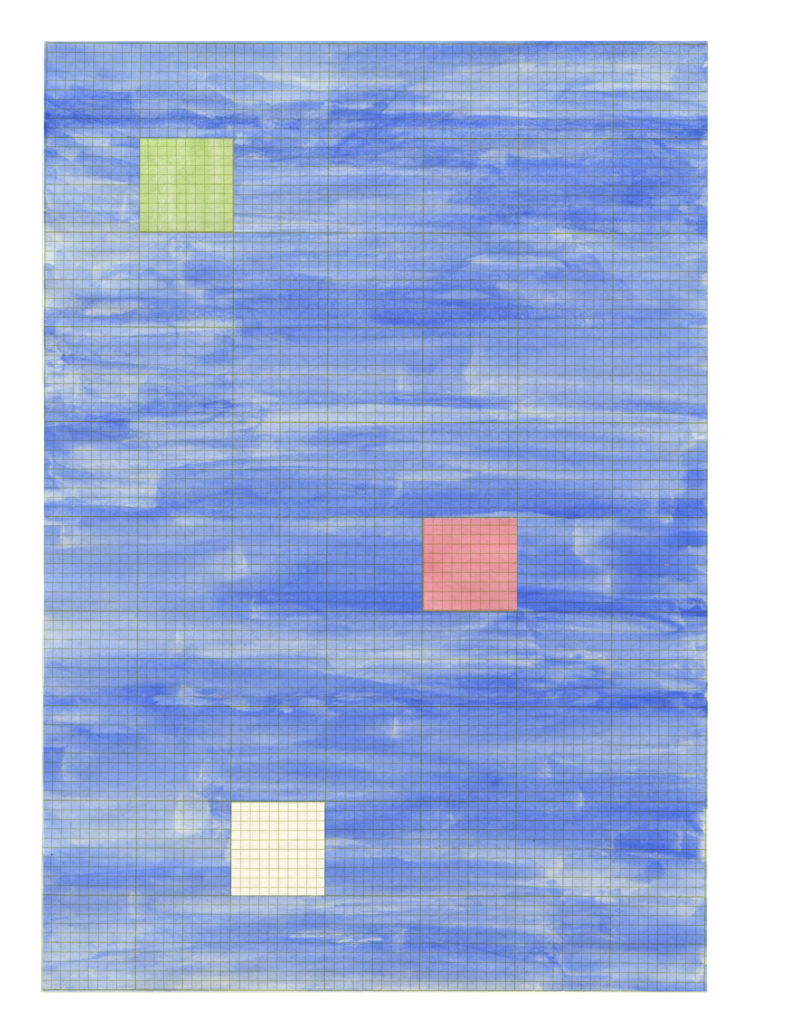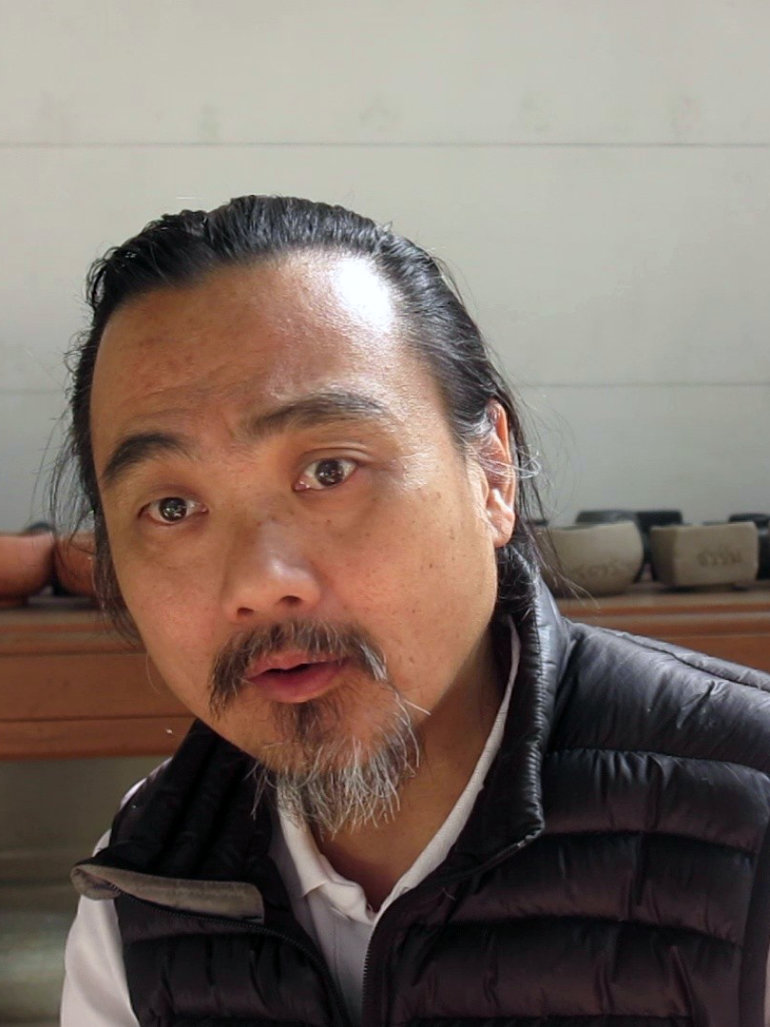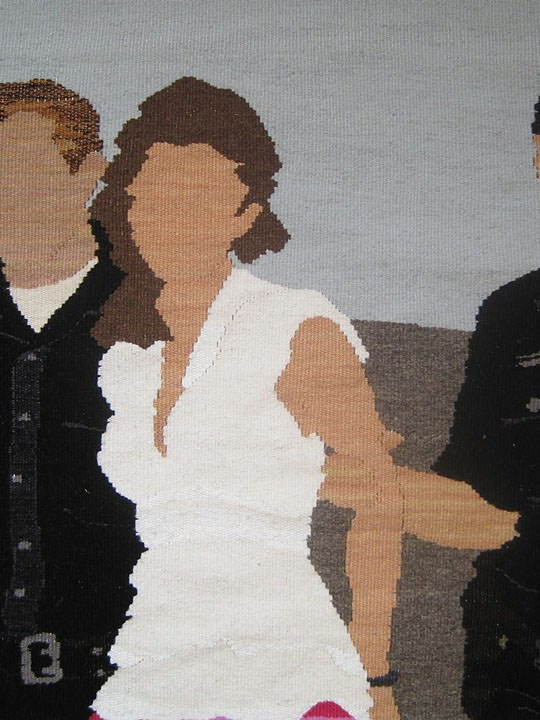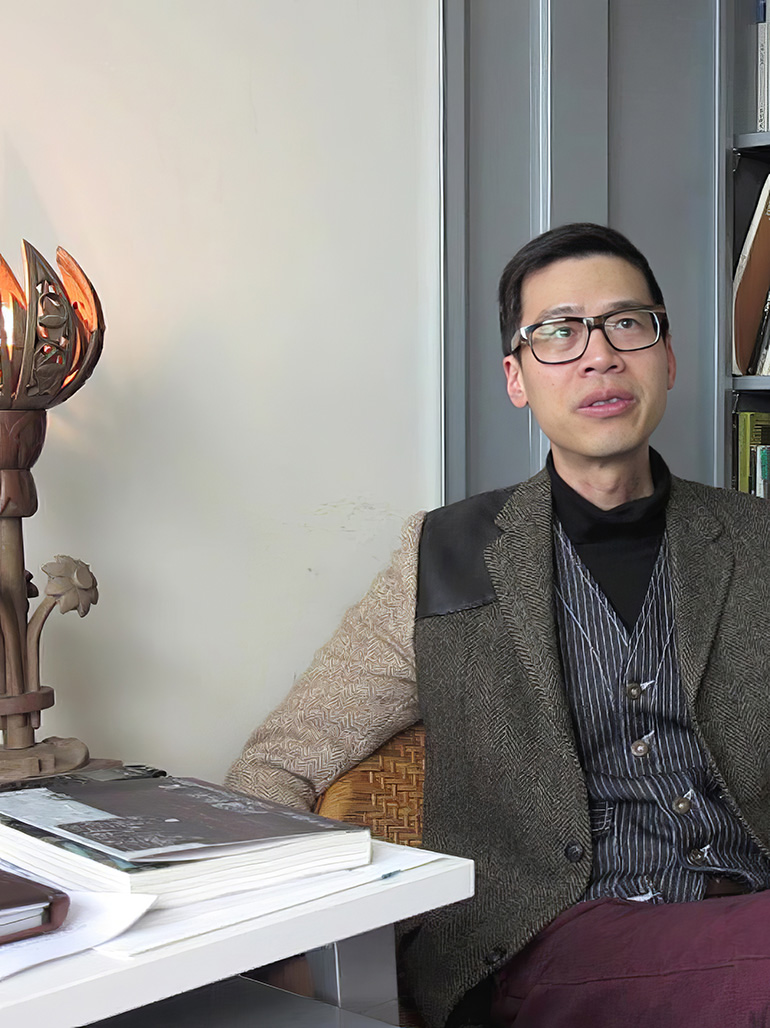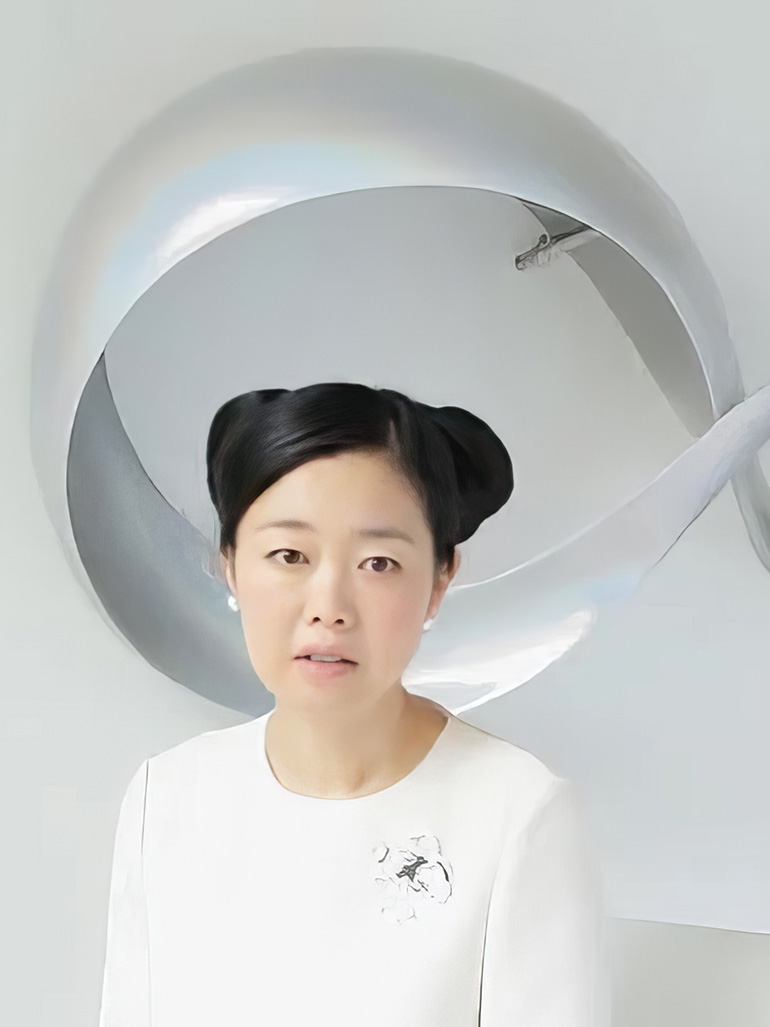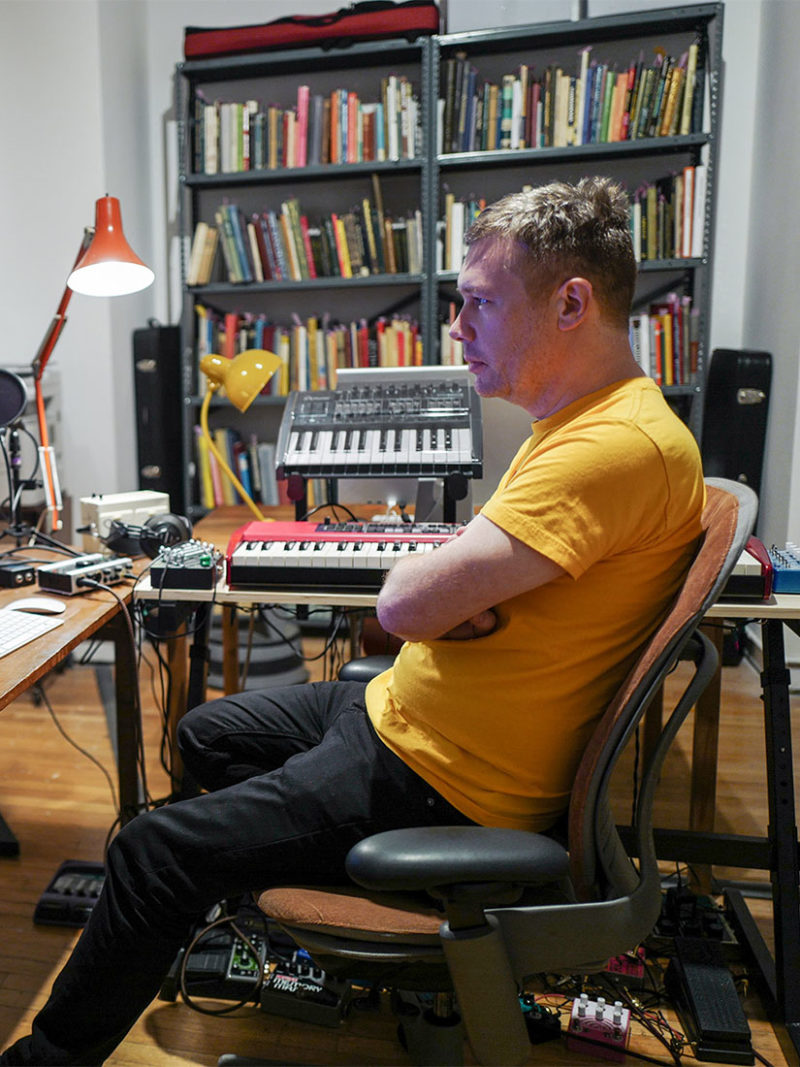
Introduction
Andrew Beccone is an artist with a master’s degree in Information and Library Science and the founder of the Reanimation Library, a collection of carefully selected books. I caught up with Andrew during his residency at the Queens Museum Studio Program 12. While there have been remote temporary iterations in cities across the US and the World, this museum is the library’s current home. When I first met Andrew, I was eager to hear his thoughts on building a space that encourages participation and collaboration. My own work relies heavily on interacting with spaces and people in performative ways and documenting the process. Andrew has taken documentation (specifically books that are often deemed worthless in today’s age, that have particularly interesting imagery) and placed them into a context that alters their meaning and value, encouraging people to interact with the content. I’ve been fascinated with the idea of creativity transcending the boundaries that we as a culture place on it and was interested to hear how he merged the two worlds of fine art and books.
Interview – Part 1
I first wanted to talk about your project, the Reanimation Library 34. I guess the first question, the starting point, is can you summarize the project in one sentence?
A library of ‘outdated’ books collected for their visual information.
So when you say outdated, what do you mean?
I put ‘outdated’ in quotes because the longer I spend working on this project, and it’s been about 14 years now, the more I’ve started questioning that word. There are some very specific ways in which the word ‘outdated’ works. There are books that I collect that you may not want to consult for treating some kind of disease because the book was written 30 years ago and since then, we’ve learned more about that disease and how to treat it. So there is something about the currency of information that can become outdated, but at the same time, books are a snapshot of the time and place that they were produced, so they are archival by nature. Therefore it is hard to consider these books outdated in the sense that I still see a lot of value in them. Obviously, for me, the main attraction to starting this project, the main reason I still select books, is primarily for their visual information, but if you start reading these books as well, there is a lot of interesting things to take away from a sociological standpoint and from a historical standpoint.
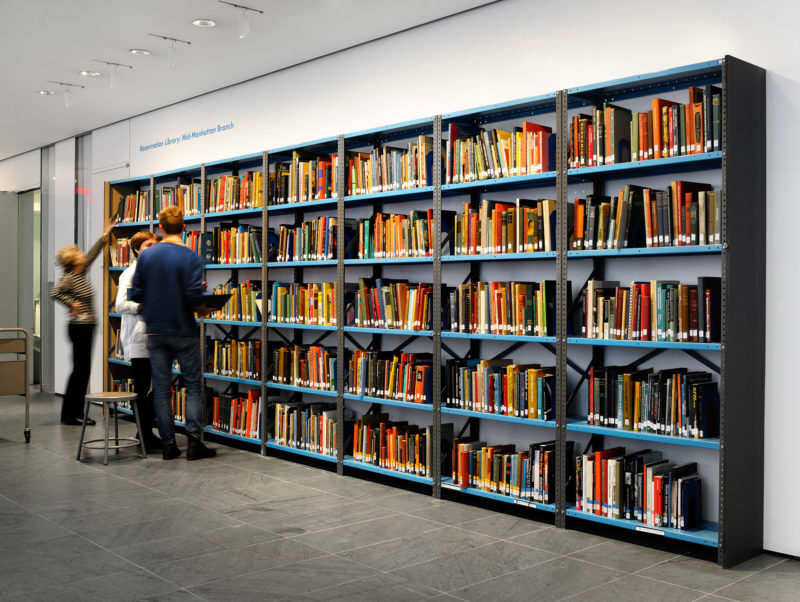
That is what is so interesting to me. It represents something. It is so indicative of that moment in time. What years do these books represent?
The bulk of it falls between the 1940s to the 1970s. I have some things as early as the 1890’s up to the 1990s, but the majority is from that time span.
When you look at it, a lot of the information is outdated, to use that word, and it somehow becomes relevant because of the fact that it is outdated.
Right. There are plenty of libraries that will have, say, a history of psychology collections, right? There is a history of a subject and our understanding of a subject usually changes over time, so these kinds of collections are important. The Reanimation Library happens to be a weird version of that because I am not trying to be completist about any subject, but you will see certain subjects repeated and well represented. That tends to be more a function of the subject itself; does it rely on visual information or not? There are plenty of subjects that are not included in this library because they don’t rely on imagery.
Like what?
Philosophy. Literature. International Law.
So every book has images?
For the most part. There is a sub-collection over there with the orange labels (Andrew points to a section of the library). That’s called the text and symbol collection, and it exists primarily because there are books like this out there (he hands me a book). It is called A Million Random Digits.
The entire book is numbers.
Random digits.
In some way it is still visual, right?
This is visually interesting to me, even though it doesn’t contain images. I am also interested in translation, and the relationship between text and image, and languages themselves. I like collecting foreign language books. Even if I can’t read a given language, I can generally have a sense of what the book is about through its images. And I am interested in things like this (he hands me another book).

Is this a book about braille?
For the sighted. There is no braille in there at all, just braille patterns. So who is this book written for? It is a really strange book. It doesn’t contain images, but it has a certain visual quality that somehow occupies a space between text and image. And I have books on shorthand – a strange writing system made primarily for clerical work. You look at it and they just look like markings, but you put enough of them together and you start to make an image.
Absolutely. I think even if it is only text, it is somehow still an image.
Right, it is a visual representation. I mean, they function in different ways, but I don’t think they are quite as separate as we often think they are.
So you have done it, how many places? How many separate libraries have you done?
I have set up 16 branch libraries 56
And all temporary?
Yes. The branch I did in LA is potentially permanent. I first set it up in Joshua Tree at High Desert 7 Test Sites and then it moved to LA at Monte Vista Projects 89. We left the books out there because one of the people that I worked on those projects with, Aurora Tang, is interested in establishing a more permanent library out there. I’m open to it, but I don’t necessarily need it to happen. I also don’t need the books back here immediately, so we will see. For the most part, though, yeah, they are all temporary. In terms of the process, I go to the city that invited me to do the branch and I start from there. I source all the books from there. I would usually exhibit work that people have created from the library and work with artists from the hosting city, so we need somehow to get materials to them ahead of time so they can start to respond. It is a really cool way to see cities. To go there and find books.
Especially when you step outside the U.S., or at least outside New York City or other big cities that are changing so fast. I’m sure it is a lot easier to find the books.
Well, it’s funny because people are always telling me they imagine how great New York must be for getting books, but actually, it is quite awful. One good thing is that you find lots of piles of discarded books on the street, but thrifting in New York is a joke.
Oh, I am sure. It is nearly impossible to find good stuff.
Smaller places like Joshua Tree and Portland, Maine, were incredible.
I have been to both and to thrift stores or antique shops in both and it is incredible.
Yeah – amazing.
So it being temporary has no importance to you? Do you have a preference?
Branch libraries have all taken place in art spaces, within an exhibition structure, which is fine with me. If this thing in LA works out, there is the logistical question of do I just give it away and say, “Here you go, start working on it”? What level of control do I try to maintain? How much can you really control something that is remote? At this point, it has not been a priority to establish another permanent space. I feel like I have enough work just building and maintaining the collection here.
You select every book in here yourself? Nothing slips by you?
Right, I am the decider. (laughs)
So if it becomes something far away from you, you have to give up some of that control in order for it to grow.
So my friend, Aurura, who I was working with in Southern California, contacted me and was very interested in the project and has a very good eye for the kind of material that I get. I went out there a couple of times to set things up and she was collecting stuff too. She collected and let me decide. She found a lot of great stuff and about 70% of what she found I kept, but I still definitely went through it. I am not quite ready to give up that aspect of that control. I very much think of it as a project that is inherently collaborative because when people are working in it, they are working directly with my project. Sometimes I work very directly with them, and that feels more visibly collaborative, but even if someone is working in it and I am not involved in what they are doing, it still feels collaborative because they are building something out of this thing that I built. There is an interesting dynamic in the library that I have come to realize, which is that I have full control over the shape of the library, the look of the library, how I talk about the library, but on the other hand, I have almost no control over what comes out of it. In fact, I don’t really need to know, or like, what comes out of it.
We could say that about anything, at the end of the day.
In a sense, yeah. For sure.
For me, what is interesting is that you are bringing people together through collaboration but also creating something that people critically would question whether it is ‘art’ and what the true purpose of the work is.
To me, this is a hybrid project. It is both a library and an artwork.
Did you intend it to be viewed in a fine art context?
It just emerged that way during the first couple of years I was working on it. I was building my own collection of source material to make visual art with but after a few years; I realized that I had stopped making art, and all of my art-making energy was going into creating the library. It felt like the same type of creative work, simply transferred to the library. That realization wasn’t a crisis at all. It was more like ‘oh, this is the work.’ The interesting thing about that is that the contemporary art world, for all the issues I have with it, has been incredibly open to the library. If you say, this is an art project or practice, the contemporary art world generally takes you at your word. It is a pretty open platform, where the idea of a library being an artwork is not so radical. The people that get freaked out by it are librarians. They don’t like to think of it as a library. My mom was a librarian who is now retired. I am a librarian. I use the Library Of Congress Classification. I catalog all of this stuff. There is a use-value aspect to it that allows people who come into this collection looking for something specific to find it if it is here. There are structures that libraries have built over many, many years that are quite effective for doing that. That is as much a part of the work as the creative process that goes into building this, so I fail to quite understand how it’s not a library.
And I am sure also the other artists’ work spawns from coming into this space.
And in that way, it is actually not that different than any library because libraries are generative spaces. It may be more unusual for visual art to emerge from them, you may think more of writing as a product of libraries, but by their nature, libraries are generative. It is funny, though, that the resistance comes from the librarians and not the art world.
I always see the people in the art world hypercritical if the librarians are worse. That is scary to me.
I think they are qualitatively different types of criticism. There is a hypercritical approach in the art world, but it seems like there is something categorically critical coming from libraries, as in “let’s circle the wagons and load the guns” critical. The former seems like criticism informed by theory or fad, whereas the latter seems like criticism generated by existential fear. As a librarian myself, I have thought a lot about this. I have two ideas about this. The first is that I collect primarily the types of books that most libraries would get rid of, so in a sense, the Reanimation Library is demonstrating the continued relevance of the material that a different library might weed from their collection, and so I could see how librarians might think that this is an implicit criticism of that practice.
Was that your intention?
Not at all. I’m very sympathetic to the practice of weeding. I understand that libraries have both limited budgets and limited space. At the end of the day, yes, you have to remove things that aren’t being used and bring new things in. They are not magical spaces that you can add to forever. My other idea is that a lot of people who become librarians are interested in classification. The Reanimation Library is somewhat difficult to categorize. It is a hybrid. What subject headings do you put on it? What is it? In the process of cataloging, librarians need to determine what we call the primary subject. A book is generally full of multiple subjects, so a librarian has to assign it a primary subject in order that it can sit on a shelf next to other books related by the same subject. So, in a way, I think that what librarians do is look at this project and say, ‘primary subject: art project’. (laughs).
Secondary subject library?
Right. And I want to make clear that this is not true of every librarian, just more of a general observation.
Is that important to you? Should it be considered both equally? Is one more important than the other to you?
I take them equally seriously. I mean, it was a source of frustration for a while and now I just kind of find it funny.
It looks to me like it is creating a lot of conversations that people should be having, be it in the art world or in the library world.
Why does it need to sit only in one? What sits in only one world…of anything that we do? The Reanimation Library simply happens to exist very explicitly in both of them. I am a visual artist and a librarian, so this is the result.
It was organic.
It was the lightbulb in the head. When I realized that I was amassing a collection that was pretty incredible from a visual standpoint, I wanted to share it.
Is it important to you that I must view it as an artwork? Or can I come in here and view it through another lens? Do I have to view it through the lens of art?
You don’t have to…it’s impossible to control how other people experience it.
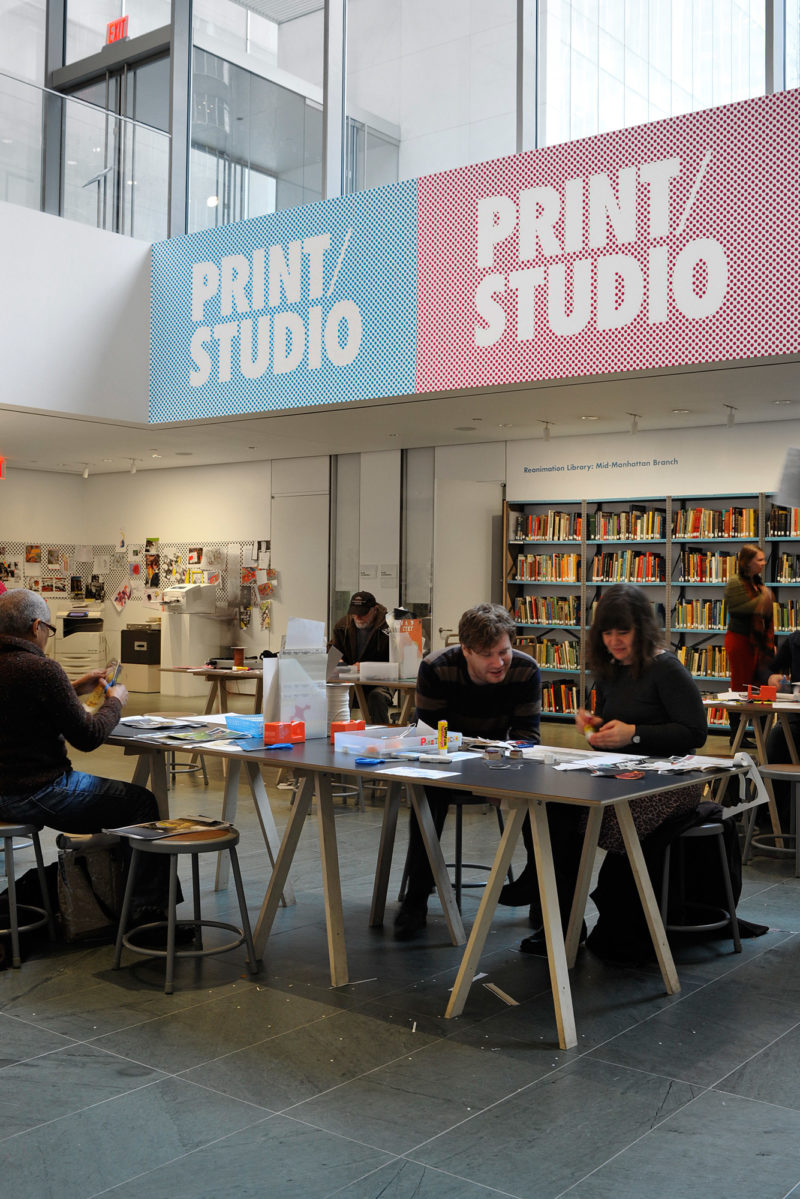
Interview – Part 2
I mean, we are in a space right now that was once called a Museum of Art and now it is simply called a Museum.
Right. But because it has been exhibited in art spaces, I think people tend to see it as an artwork because that’s how it has been framed. In New York, which is still very much the center of the art world, there is a fairly high level of sophistication around the discourse of art. In this context, most people don’t question its validity as an artwork. I have set up branch libraries in places that are much smaller where people will say to me, this isn’t art.
That is, to me, what is so interesting about your work. It is breeding this conversation. Maybe less so in New York because people are just so overly open-minded or pretend to be, I don’t know which one it is, but people are not quick to judge and generally accept before they judge.
Yeah, exactly. I am sure there is some of both.
I mean that it is questioning what a library means or what art means to them, and I think that is endlessly important. It is so different than what most people are doing.
There are precedents, though. I mean, conceptual art has been around for what, 50, 60 years?. It was once this radical idea that an idea could be the artwork. But even so, there are plenty of people who don’t believe that. There’s still plenty of conservative schools of thought. I basically stopped worrying about any of that, though, which is probably a direct result of the library world continually referring to it as ‘just an art project. Just.
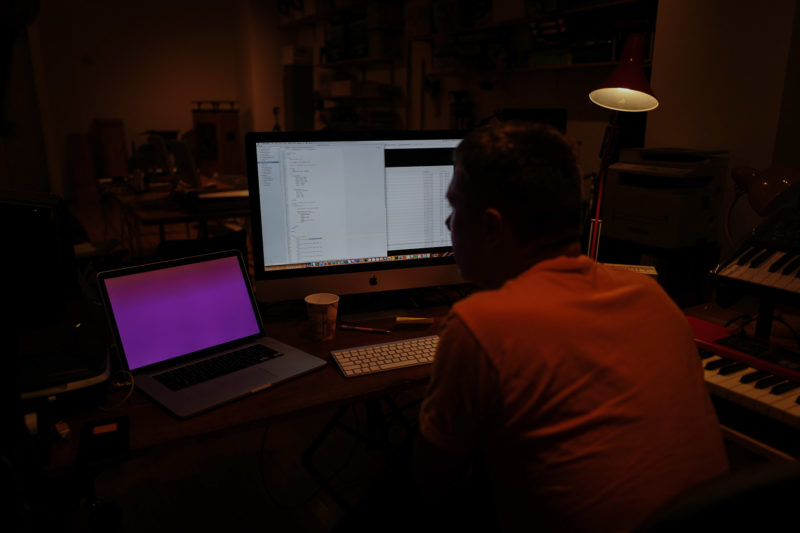
Would you show this in a library if it came to you?
I have always wanted to work within a big public research library like New York Public and extract the Reanimation Library that exists within its collection. They have the storage capacity and funds to hold onto a huge collection, so I would love to be able to work in, extract, and activate it as a Reanimation branch. That would be super interesting to me.
Have you tried to do this?
The first branch library I did was in Philadelphia at Vox Populi 1011. I connected with the Philadelphia Public Library and went to the central library, and found 30 or 40 books that I thought would be good, but when it came down to it, they did not want to officially collaborate. They were just not interested, but they were like, you can check the books out, so we checked the books out and brought them into the space.
So you build the entire library from rented books?
No, about half. The rest I went out and bought.
Did you label them?
No, I used their labels. I wanted to see what kind of stuff I could still find that hadn’t been weeded out. As it turns out, I didn’t actually find a lot of material that worked for me. New York Public is a different case because it is basically a world-class research library with an unbelievable collection.
What you’re doing is research at the end of the day. I think most artists go into the studio and know how things will generally start and end, and you seemingly are not sure of the outcome.
Yeah. I sort of hit a block last year. There is so much routine to library work. I’m sick of cataloging. The administrative aspect to library work can be pretty monotonous. It was exciting when I was starting it because I was building my own database and trying to figure out how I wanted to do it, but now it’s less interesting to me.
Do you have help?
I’ve had many great interns over the years who help me with the more administrative aspects of keeping the library going. But more recently, I have been realizing that I built a pretty cool playground, and I that now want to play in it, so I’ve been shifting back towards making things that are more identifiable as art.
And maybe that is the way it is supposed to be.
Totally. And that, in turn, has revitalized my interest in this project. It’s been 14 years. Does it end? Do these sorts of projects need to go on forever? I’ve always maintained that I will do it until I am tired of it, and I hit a point last year where I was like, ‘this may be the point where I am no longer interested’ and then I lost my space and…
That was before the residency here?
Right. I was in a space for 9 years in Brooklyn. My first thought was, ‘fuck, I need to get a new space.’ That made me realize I am not done. It is not done. My instincts kicked in.
When you couldn’t let it go?
That would have been the perfect time to let it go. It would have been easy, but it isn’t finished yet, and I am happy it is still going.
Why do the residency then? The lack of space?
Partially the space, yeah. Well, this program is incredible. It is totally amazing. In the last few years, I have been making more traditional, identifiable artworks again, and in my last place, I really didn’t have space to do that. It was open to the public – there was no door to close off the library, and I didn’t have the funds to pay for another studio. The Queens Museum Studio Program afforded me a place to house the library and be able to give people access on a more limited basis than before, but I can also shut the door and work on whatever I am working on. That is one of the things that has been great about this opportunity – the things it has allowed me to work on in addition to the library.
What else are you working on in the space then?
A couple of things.
Can I see? (laughs)
Sure! Well, one thing I am working on comes directly from the library. Some things do and some things don’t, but this does. It is the result of a guy named Giovanni Civitenga who lives in Berlin but runs a radio show in London, asking me last year to make something for his show. I asked him what he wanted and he said I could do whatever I want but it has to be audio, and it has to relate to the library.
So you’re a visual artist, but now you’re working with no visual component?
Right, no visual component. The show is called Skyapnea.
Great name.
Right? He told me that he had started approaching artists and asking them to create pieces for the show, so I have been working on something that grew out of a series of performative readings that I have been doing for the past couple of years. (Which itself grew out of growing tired of giving the usual spiel about the library when I was invited to talk about it). A few years ago, I started a project called An Incomplete Portrait Of The Reanimation Library. I go through the books and find paragraphs or lists or any section of text that I found interesting, and then I sequence them and read them out loud. In most cases, I have a visual component as well, though. Working on this project has made me appreciate how strange some of the text is in these books.
Something written in the ’40s is already strange, I am sure.
Yeah, yeah. The way things are phrased…These kinds of books are usually cleansed of any personality, so when I find any small element of the author’s personality, I love it. There are little moments when they breakthrough, which can be weird and jarring.
A lot of politically incorrect stuff, I am sure.
A lot.
So…
I started to get a little tired of the Incomplete Portrait project primarily because I didn’t want to be the only one reading, so I started inviting other people to read text that I had selected. In one case, I worked with a small group of people to collaboratively find, sequence and read a piece. But for this Skyapena project, I have been inviting people to the library to find sections of text that interest them, and then I record them and manipulate those recordings. I can play them for you if you’d like.
Sure!
I’m also a drummer and last year thought about how much I miss working with sound. So I started buying all this equipment that I can’t play in order to make a sound.
So you have a guitar and a bass, but you cannot play them?
No, just the basics. I just wanted tools to generate sounds.
(laughing) In everything you do, you somehow test the limits of what people create things for. Someone made that guitar to be played a certain way, someone made a library system and expected it to be used in a certain way…
I guess I am just not interested in other people’s expectations. (laughs)
So is this what you will play for the station?
Yeah. It’s not done yet, but these are some of the things that will be used—a glimpse.
Is it hard to step away from visual art?
No, because I have played music since I was 6. It’s been interesting to integrate another aspect of who I am. To bring that into this space was really exciting to me. All of my work appears to be me turning in to myself.
As happens with most artists.
(plays the track)
That is unnerving.
It is a little unnerving.
It made my stomach turn.
Yeah. And then there is a record there that came from a book from a branch in Germany – it’s about irregular heartbeats, so it has heartbeat sounds interspersed with a man speaking in German, assumably about the heartbeats. I digitized the record and then added this drone track underneath it.
And that is this track?
Yeah. (track plays)
Is that standard having books with records in it?
Not standard, but you see it from time to time.
Have you decided what you will play on the station?
No, not yet. I am at the place where I have all the source materials, but I haven’t worked through it all yet. Gio has been very laid back and will let me choose what to play. I have two hours to work with, so I can use all of it or some of it. I had these grand ambitions for a two-hour sound piece, but that started to seem unnecessary and arbitrary, so now we’ll just see what happens. It’ll be as long as it needs to be, I suppose.
So he will introduce it?
Yeah, it will be a mixture of these kinds of tracks and probably of some other stuff like ambient sounds that I have been recording in the museum. I have an amazing recording of a youth orchestra rehearsing in the main space of the museum, and they were pretty bad, you know, but it was charming—that kind of bad. I was like, oh my God, and went out and started recording it. So I might incorporate some of that material. But I’m also teaching myself all of this – I’m just starting to figure out Logic Pro.
This isn’t a standard place a visual artist would show something, and yet you still agree to do it. Is it because you are bored with the books and other visual art?
When people approach me with opportunities like that, I am inclined to say yes because it’s like an assignment. Given the fact that I had already been doing readings, it made sense to me to use that as the starting point. It seemed like an obvious and easy way to produce audio material and to connect the library to other people by inviting them to read from the books. I like that they often sound strange being read out loud. For the most case, these are not books that were meant to be read out loud.
What is the last thing you said no to that you wish you could go back and change your answer? Maybe not because it was a great opportunity but rather because you could have learned from it? Or you wanted to work with the person?
To be perfectly honest, I say ‘yes’ most of the time. There are things that I would have said ‘no’ to. (laughs)
That is a learning experience as well.
Exactly. Initially, I was just like ‘yes, yes yes’ to everything. But in terms of the radio show, I pay attention to contemporary art, and within that context, working with sound is not particularly radical.
I mean, it is super radical compared to the room we are standing in. If they know you for this work, the library, and they reach out to you to ask you to do something with sound on a radio station, that seems pretty radical to me.
And that is why I said yes (laughs). There is actually this guy Gill Arno, a sound artist who did an audio portrait of the library a few years back. He came into the space and set up microphones around the space for four days and recorded the sounds of the room. He captured sounds of scanning, and of people, and of the building itself. Then he did a performance of that in the space with a four-channel mixer, and he mixed for a live audience. It was very, very nice.
Were they playing at the same time?
Yeah, he was mixing the four tracks: only the recordings he did, no other music.
I want to hear it.
I will find it in my archives. Plus, I have all these new instruments and I had to find a way to use them.
You had to justify the purchases.
(laughs) I know, right? I have also been doing some watercolor works. Again – I have no real idea at this point what those might lead to, but I have done other projects using JavaScript to create animations, so I might do something similar with these. (shows artworks on the computer). I Learned JavaScript the same way I’m learning Logic Pro – when I want to learn how to do something specific, I look online.
Interview – Part 3
That is generally how I work as well. I just search something I want to learn to do and try to learn through Google. With the
It is always helpful to start by wanting to know how to do it. I may buy the whole book on how to use Logic Pro or whatever…
But then you skip to the page you want to learn about.
Yeah, yeah. And generally, it is quicker to just search online. I have learned a lot from youtube.
Ok, I have one last question for you. What do you think the importance of books is in the future and what will the idea of books look like years from now?
I would have probably given a different answer 3 or 4 years ago. I would have probably said their role would be significantly decreased. More and more people would use internet-connected devices. There are many advantages to that, with research and access for example…
The environmental reasons behind not printing books on paper.
Exactly, the environmental advantages. But there are also some very scary questions about digital perseverations. I was born in 1974. I remember having 5¼-inch floppy disks and 3½-inch floppy disks. Zip disks. Very few people can access the information on those storage devices anymore. There’s like 20 years of information locked up in formats that we cannot access. Books have a pretty kick-ass track record. They have lasted a long time. They are pretty stable and they don’t require any additional technology to read them. Then you look at the sale of vinyl records and it is the best it has been in 25 years. I think there is a qualitative difference between how we interact with analog and digital. Digital has a ton of advantages in terms of access, in terms of the amount you can store and take with you, but it has its disadvantages too. There is visual flattening out that happens with screens – everything starts to appear homogenous. Whereas there is a lot more variation with analog material. I don’t think it is just a novelty. The tactility, the smells, the subtle variations, the sensual aspects of books and other physical materials. You feel its weight. You smell it, you see it. The paper stock varies. These are all qualities a website that 80,000 people have visited in the past hour doesn’t have. So I think I used to think the role that books play in our lives would decrease significantly, but now I am not so sure. Ebook sales are going down, print book sales are going up. Here is my thing: I want both. I see no reason that analog and digital should not exist side by side.
